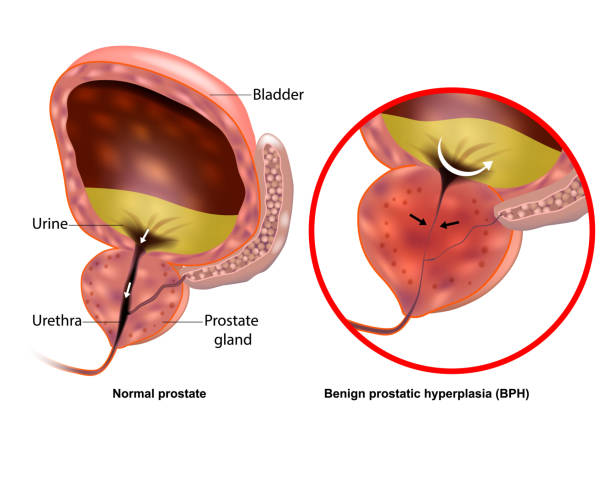Benign Prostatic Hyperplasia (BPH) is a benign condition that occurs in men, particularly with age. It is the benign growth of the prostate gland, and its growth can cause urination problems. Although common, there are some myths regarding BPH that instill unnecessary fear. Once the myths, facts, and treatment options such as drugs like urimax d are known, one can treat the disease successfully.
Myths and Facts About BPH
Myth 1: BPH Always Leads to Prostate Cancer
- Fact: BPH and prostate cancer are two different diseases. Though both affect the prostate gland, BPH is benign (non-malignant) enlargement, whereas prostate cancer involves the development of malignant cells. BPH has no risk of developing prostate cancer, but regular check up is essential to monitor the prostate.
Myth 2: Elderly Men Are the Only Ones Affected with BPH
- Fact: Even if BPH is prevalent among men aged 50 and above, younger men are not immune to acquiring the condition. Genes, lifestyle, and other diseases may predispose to early onset of prostate enlargement.
Myth 3: Surgery Is the Only Cure for BPH
- Fact: Most cases of BPH can be effectively treated with medications such as Urimax D, behavioral changes, and minimal treatment. Surgery is typically reserved for complicated cases where other treatments offer no relief.
Myth 4: BPH Symptoms Are Irreversible and Inevitable
- Fact: Although BPH is a progressive disease, symptoms of BPH can be managed using the right treatment. Medicines, dietary changes, and periodic health check-ups ensure effective management of the disease.
Causes and Symptoms of BPH
Causes
The cause of BPH is unknown as yet, though some reasons lead to its development:
- Aging: With increasing age because hormonal changes influence prostate growth.
- Hormonal Imbalance: Alteration in the levels of testosterone and estrogen may predispose prostate enlargement.
- Genetics: Positive family history of BPH makes it more likely for an individual to develop BPH.
- Lifestyle Factors: Obesity, sedentary lifestyle, and dietary factors may be responsible for prostate conditions.
Symptoms
Symptoms of BPH range from mild to severe and can affect daily life. Most prevalent symptoms are:
- Frequent urination, particularly during the night (nocturia)
- Dysuric or interrupted stream of urine
- Problematic initiation or cessation of the urine flow
- Sensation that the bladder is not emptied
- Need to urinate urgently
- Dribbling of urine after voiding
If left untreated, BPH can cause complications like urinary retention, bladder infection, and kidney damage.
Treatment of BPH
1. Medications
Drugs are usually the initial treatment for BPH. Urimax D is usually given to alleviate urine symptoms by relaxing prostate and bladder neck muscles, facilitating easy passage of urine. Other drugs are:
- Alpha-blockers: Ease the muscles of the prostate and bladder for enhanced urine flow.
- 5-alpha reductase inhibitors: Shrink the size of the prostate by blocking hormonal conversion.
- Combination therapy: A few patients are benefited by a combination of other drugs for better control of symptoms.
2. Lifestyle Changes
There are some lifestyle changes that can effectively cure BPH symptoms:
- Increase Fluid Intake: Drink ample but not excess fluid at night.
- Decrease Caffeine and Alcohol: These irritate the bladder and exacerbate symptoms.
- Exercise Daily: Regular daily exercise alleviates symptoms and maintains healthy prostates.
- Eat a Healthy Diet: Fiber-rich, healthy fat, and antioxidant-rich diet may enhance prostate function.
3. Minimally Invasive Treatments
For moderate to severe symptoms for which drugs are not effective, minimally invasive treatments exist, including:
- Transurethral Microwave Therapy (TUMT): Shrinks prostate tissue using microwave energy.
- UroLift System: Inserts lifts the enlarged prostate off the urethra.
- Prostatic Artery Embolization (PAE): Decreases prostate blood supply to shrink the size.
4. Surgery
If BPH symptoms are too severe to be addressed in other ways, surgery may become the solution. Surgical operations most commonly involve:
- Transurethral Resection of the Prostate (TURP): Is a procedure where excess prostate tissue is removed to allow urine to flow more freely.
- Holmium Laser Enucleation of the Prostate (HoLEP): Utilizes a laser to vaporize prostate tissue and dislodge the blockage.
Final Thoughts
Benign Prostatic Hyperplasia (BPH) is a condition that can be managed with numerous different treatment modalities. Awareness of BPH myths and facts will help one make the appropriate choices regarding their prostate management. Drugs such as Urimax D, along with lifestyle modifications and medical treatment, have a crucial role to play in symptom control. If you are having symptoms of BPH, seek guidance from a health care provider about the most effective treatment regimen for you.


